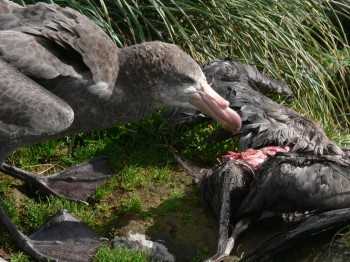Hanna Granroth-Wilding (Department of Biosciences Division of Ecology and Evolution, University of Helsinki, Finland) and Richard Phillips have an accepted paper in the journal Ibis that considers segregation within and between the two species of ACAP-listed giant petrels Macronectes spp.
The paper’s abstract follows:
“Biological communities are shaped by competition between and within species. Competition is often reduced by inter- and intra-specific specialization on resources, such as differences in foraging areas or time, allowing similar species to coexist and potentially contributing to reproductive isolation. Here, we examine the simultaneous role of temporal and spatial foraging segregation within and between two sympatric sister species of seabirds, Northern Macronectes halli and Southern M. giganteus Giant Petrels. These species show marked sexual size dimorphism and allochrony (with earlier breeding by Northern Giant Petrels), but this is the first study to test for differences in foraging behaviours and areas across the entire breeding season both between the two species and between the sexes. We tracked males and females of both species in all breeding stages at Bird Island, South Georgia, to test how foraging distribution, behaviour and habitat use varies between and within species in biological time (incubation, brood-guard or post-brood stages) and in absolute time (calendar date). Within each breeding stage, both species took trips of comparable duration to similar areas, but due to breeding allochrony they segregated temporally. Northern Giant Petrels had a somewhat smaller foraging range than Southern Giant Petrels, reflecting their greater exploitation of local carrion and probably contributing to their recent higher population growth. Within species, segregation was spatial, with females generally taking longer, more pelagic trips than males. Both sexes of both species showed unexpectedly plastic foraging behaviour, and there was little evidence of inter-specific differences in habitat use. Thus, in giant petrels, temporal segregation reduces inter-specific competition and sexual segregation reduces intra-specific competition. These results demonstrate how both specialization and dynamic changes in foraging strategies at different scales underpin resource division within a community.”

Southern Giant Petrel, photograph by Greg Hofmeyr

Feeding Northern Giant Petrel, photograph by Marienne de Villiers
Reference:
Granroth-Wilding, H.M.V. & Phillips, R.A. 2018. Segregation in space and time explains the coexistence of two sympatric sub-Antarctic petrels. Ibis doi: 10.1111/ibi.12584.
John Cooper, ACAP Information Officer, 05 March 2018

 English
English  Français
Français  Español
Español